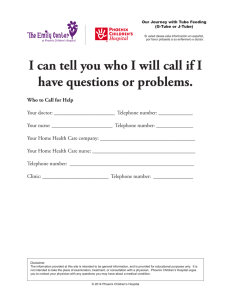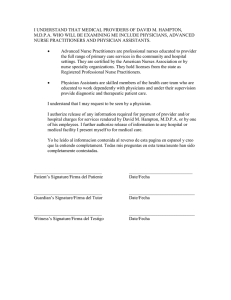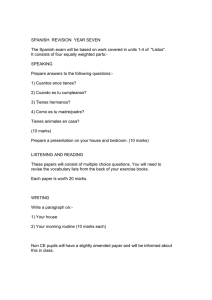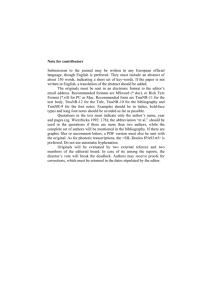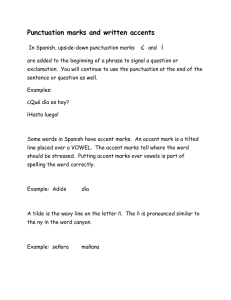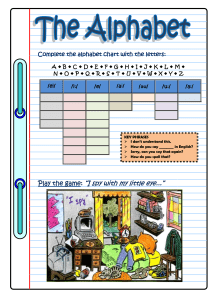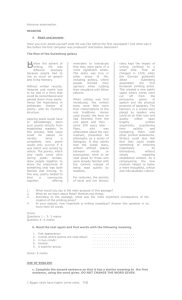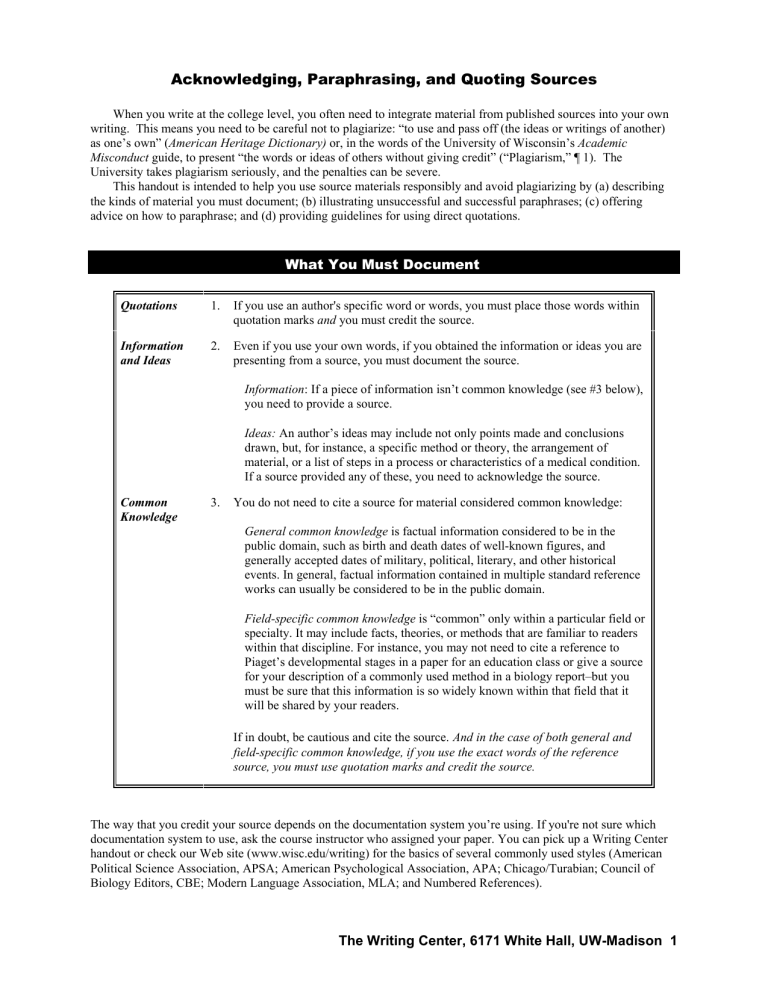
Acknowledging, Paraphrasing, and Quoting Sources When you write at the college level, you often need to integrate material from published sources into your own writing. This means you need to be careful not to plagiarize: “to use and pass off (the ideas or writings of another) as one’s own” (American Heritage Dictionary) or, in the words of the University of Wisconsin’s Academic Misconduct guide, to present “the words or ideas of others without giving credit” (“Plagiarism,” ¶ 1). The University takes plagiarism seriously, and the penalties can be severe. This handout is intended to help you use source materials responsibly and avoid plagiarizing by (a) describing the kinds of material you must document; (b) illustrating unsuccessful and successful paraphrases; (c) offering advice on how to paraphrase; and (d) providing guidelines for using direct quotations. What You Must Document Quotations 1. If you use an author's specific word or words, you must place those words within quotation marks and you must credit the source. Information and Ideas 2. Even if you use your own words, if you obtained the information or ideas you are presenting from a source, you must document the source. Information: If a piece of information isn’t common knowledge (see #3 below), you need to provide a source. Ideas: An author’s ideas may include not only points made and conclusions drawn, but, for instance, a specific method or theory, the arrangement of material, or a list of steps in a process or characteristics of a medical condition. If a source provided any of these, you need to acknowledge the source. Common Knowledge 3. You do not need to cite a source for material considered common knowledge: General common knowledge is factual information considered to be in the public domain, such as birth and death dates of well-known figures, and generally accepted dates of military, political, literary, and other historical events. In general, factual information contained in multiple standard reference works can usually be considered to be in the public domain. Field-specific common knowledge is “common” only within a particular field or specialty. It may include facts, theories, or methods that are familiar to readers within that discipline. For instance, you may not need to cite a reference to Piaget’s developmental stages in a paper for an education class or give a source for your description of a commonly used method in a biology report–but you must be sure that this information is so widely known within that field that it will be shared by your readers. If in doubt, be cautious and cite the source. And in the case of both general and field-specific common knowledge, if you use the exact words of the reference source, you must use quotation marks and credit the source. The way that you credit your source depends on the documentation system you’re using. If you're not sure which documentation system to use, ask the course instructor who assigned your paper. You can pick up a Writing Center handout or check our Web site (www.wisc.edu/writing) for the basics of several commonly used styles (American Political Science Association, APSA; American Psychological Association, APA; Chicago/Turabian; Council of Biology Editors, CBE; Modern Language Association, MLA; and Numbered References). The Writing Center, 6171 White Hall, UW-Madison 1 Sample Paraphrases–Unsuccessful and Successful Paraphrasing is often defined as putting a passage from an author into “your own words.” But what are your own words? How different must your paraphrase be from the original? The paragraphs below provide an example by showing a passage as it appears in the source (A), two paraphrases that follow the source too closely (B and C), and a legitimate paraphrase (D). The student’s intention was to incorporate the material in the original passage A into a section of a paper on the concept of “experts” that compared the functions of experts and nonexperts in several professions. A. The Passage as It Appears in the Source (indented to indicate a lengthy direct quotation) Critical care nurses function in a hierarchy of roles. In this open heart surgery unit, the nurse manager hires and fires the nursing personnel. The nurse manager does not directly care for patients but follows the progress of unusual or long-term patients. On each shift a nurse assumes the role of resource nurse. This person oversees the hour-by-hour functioning of the unit as a whole, such as considering expected admissions and discharges of patients, ascertaining that beds are available for patients in the operating room, and covering sick calls. Resource nurses also take a patient assignment. They are the most experienced of all the staff nurses. The nurse clinician has a separate job description and provides for quality of care by orienting new staff, developing unit policies, and providing direct support where needed, such as assisting in emergency situations. The clinical nurse specialist in this unit is mostly involved with formal teaching in orienting new staff. The nurse manager, nurse clinician, and clinical nurse specialist are the designated experts. They do not take patient assignments. The resource nurse is seen as both a caregiver and a resource to other caregivers. . . . Staff nurses have a hierarchy of seniority . . . . Staff nurses are assigned to patients to provide all their nursing care. (Chase, 1995, p. 156) B. Word-for-Word Plagiarism Critical care nurses have a hierarchy of roles. The nurse manager hires and fires nurses. S/he does not directly care for patients but does follow unusual or long-term cases. On each shift a resource nurse attends to the functioning of the unit as a whole, such as making sure beds are available in the operating room, and also has a patient assignment. The nurse clinician orients new staff, develops policies, and provides support where needed. The clinical nurse specialist also orients new staff, mostly by formal teaching. The nurse manager, nurse clinician, and clinical nurse specialist, as the designated experts, do not take patient assignments. The resource nurse is not only a caregiver but a resource to the other caregivers. Within the staff nurses there is also a hierarchy of seniority. Their job is to give assigned patients all their nursing care. Notice that the writer has not only "borrowed" Chase's material (the results of her research) with no acknowledgment, but has also largely maintained the author's method of expression and sentence structure. The underlined phrases are directly copied from the source or changed only slightly in form. Even if the student-writer had acknowledged Chase as the source of the content, the language of the passage would be considered plagiarized because no quotation marks indicate the phrases that come directly from Chase. And if quotation marks did appear around all these phrases, this paragraph would be so cluttered that it would be unreadable. C. A Patchwork Paraphrase Chase (1995) described how nurses in a critical care unit function in a hierarchy that places designated experts at the top and the least senior staff nurses at the bottom. The experts--the nurse manager, nurse clinician, and clinical nurse specialist--are not involved directly in patient care. The staff nurses, in contrast, are assigned to patients and provide all their nursing care. Within the staff nurses is a hierarchy of seniority in which the most senior can become resource nurses: they are assigned a patient but also serve as a resource to other caregivers. The experts have administrative and teaching tasks such as selecting and orienting new staff, developing unit policies, and giving hands-on support where needed. This paraphrase is a patchwork composed of pieces in the original author’s language (underlined) and pieces in the student-writer’s words, all rearranged into a new pattern, but with none of the borrowed pieces in quotation marks. Thus, even though the writer acknowledges the source of the material, the underlined phrases are falsely presented as the student’s own. The Writing Center, 6171 White Hall, UW-Madison 2 D. A Legitimate Paraphrase In her study of the roles of nurses in a critical care unit, Chase (1995) also found a hierarchy that distinguished the roles of experts and others. Just as the educational experts described above do not directly teach students, the experts in this unit do not directly attend to patients. That is the role of the staff nurses, who, like teachers, have their own “hierarchy of seniority” (p. 156). The roles of the experts include employing unit nurses and overseeing the care of special patients (nurse manager), teaching and otherwise integrating new personnel into the unit (clinical nurse specialist and nurse clinician), and policy-making (nurse clinician). In an intermediate position in the hierarchy is the resource nurse, a staff nurse with more experience than the others, who assumes direct care of patients as the other staff nurses do, but also takes on tasks to ensure the smooth operation of the entire facility. The writer has documented Chase’s material and specific language (by direct reference to the author and by quotation marks around language taken directly from the source). Notice too that the writer has modified Chase's language and structure and has added material to fit the new context and purpose—to present the distinctive functions of experts and nonexperts in several professions. Perhaps you’ve noticed that a number of phrases from the original passage appear in the legitimate paraphrase in D above: critical care, staff nurses, nurse manager, clinical nurse specialist, nurse clinician, resource nurse. If all these were underlined, the paraphrase would look much like the “patchwork” in example C. The difference is that the phrases in D are all precise, economical, and conventional designations that are part of the shared language within the nursing discipline (in B and C, they’re underlined only when used within a longer borrowed phrase). In every discipline and in certain genres (such as the empirical research report), some phrases are so specialized or conventional that you can’t paraphrase them except by wordy and awkward circumlocutions that would be less familiar (and thus less readable) to the audience. When you repeat such phrases, you’re not stealing the unique phrasing of an individual writer but using a common vocabulary shared by a community of scholars. Some Examples of Shared Language You Don’t Need to Put in Quotation Marks • Conventional designations: e.g., physician’s assistant, chronic low-back pain • Preferred bias-free language: e.g., persons with disabilities • Technical terms and phrases of a discipline or genre: e.g., reduplication, cognitive domain, material culture, sexual harassment How to Paraphrase General Advice 1. When reading a passage, try first to understand it as a whole, rather than pausing to write down specific ideas or phrases. 2. Be selective. Unless your assignment is to do a formal or “literal” paraphrase,* you usually don’t need to paraphrase an entire passage; instead, choose and summarize the material that helps you make a point in your paper. 3. Think of what “your own words” would be if you were telling someone who’s unfamiliar with your subject (your mother, your brother, a friend) what the original source said. 4. Remember that you can use direct quotations of phrases from the original within your paraphrase, and that you don’t need to change or put quotation marks around shared language (see box above). *See Spatt (1999), pp. 99-103; paraphrase is used in this handout in the more common sense of a summary-paraphrase or what Spatt calls a “free paraphrase” (p. 103). The Writing Center, 6171 White Hall, UW-Madison 3 Methods of Paraphrasing A. Look away from the source; then write. Read the text you want to paraphrase several times—until you feel that you understand it and can use your own words to restate it to someone else. Then, look away from the original and rewrite the text in your own words. B. Take notes. Take abbreviated notes; set the notes aside; then paraphrase from the notes a day or so later, or when you draft. If you find that you can’t do A or B, this may mean that you don’t understand the passage completely or that you need to use a more structured process until you have more experience in paraphrasing. The method below is not only a way to create a paraphrase but also a way to understand a difficult text. C. While looking at the source, first change the structure, then the words. For example, consider the following passage from Love and Toil (a book on motherhood in London from 1870 to 1918), in which the author, Ellen Ross, puts forth one of her major arguments: Love and Toil maintains that family survival was the mother’s main charge among the large majority of London’s population who were poor or working class; the emotional and intellectual nurture of her child or children and even their actual comfort were forced into the background. To mother was to work for and organize household subsistence. (p. 9) 1. Change the structure. C Begin by starting at a different place in the passage and/or sentence(s), basing your choice on the focus of your paper. This will lead naturally to some changes in wording. Some places you might start in the passage above are “The mother’s main charge,” “Among the . . . poor or working class,” “Working for and organizing household subsistence,” or “The emotional and intellectual nurture.” Or you could begin with one of the people the passage is about: “Mothers,” “A mother,” “Children,” “A child.” Focusing on specific people rather than abstractions will make your paraphrase more readable. C At this stage, you might also break up long sentences, combine short ones, expand phrases for clarity, or shorten them for conciseness, or you might do this in an additional step. In this process, you’ll naturally eliminate some words and change others. Here’s one of the many ways you might get started with a paraphrase of the passage above by changing its structure. In this case, the focus of the paper is the effect of economic status on children at the turn of the century, so the writer begins with children: Children of the poor at the turn of the century received little if any emotional or intellectual nurturing from their mothers, whose main charge was family survival. Working for and organizing household subsistence were what defined mothering. Next to this, even the children’s basic comfort was forced into the background (Ross, 1995). Now you’ve succeeded in changing the structure, but the passage still contains many direct quotations, so you need to go on to the second step: The Writing Center, 6171 White Hall, UW-Madison 4 2. Change the words . C C Use synonyms or a phrase that expresses the same meaning. Leave shared language (box, p. 3) unchanged. It’s important to start by changing the structure, not the words, but you might find that as you change the words, you see ways to change the structure further. The final paraphrase might look like this: According to Ross (1993), poor children at the turn of the century received little mothering in our sense of the term. Mothering was defined by economic status, and among the poor, a mother’s foremost responsibility was not to stimulate her children’s minds or foster their emotional growth but to provide food and shelter to meet the basic requirements for physical survival. Given the magnitude of this task, children were deprived of even the “actual comfort” (p. 9) we expect mothers to provide today. You may need to go through this process several times to create a satisfactory paraphrase. Using Direct Quotations Use direct quotations only if you have a good reason. Most of your paper should be in your own words. Reasons for Quoting • To show that an authority supports your point • To present a position or argument to critique or comment on • To include especially moving or historically significant language • To present a particularly well-stated passage whose meaning would be lost or changed if paraphrased or summarized Introducing Quotations One of your jobs as a writer is to guide your reader through your text. Don’t simply drop quotations into your paper and leave it to the reader to make connections. Integrating a quotation into your text usually involves two elements: • • A signal that a quotation is coming—generally the author’s name and/or a reference to the work An assertion that indicates the relationship of the quotation to your text Often both the signal and the assertion appear in a single introductory statement, as in the example below. Notice how a transitional phrase also serves to connect the quotation smoothly to the introductory statement. Ross (1993), in her study of poor and working-class mothers in London from 1870-1918 [signal], makes it clear that economic status to a large extent determined the meaning of motherhood [assertion]. Among this population [connection], “To mother was to work for and organize household subsistence” (p. 9). The signal can also come after the assertion, again with a connecting word or phrase: Illness was rarely a routine matter in the nineteenth century [assertion]. As [connection] Ross observes [signal], “Maternal thinking about children’s health revolved around the possibility of a child’s maiming or death” (p. 166). The Writing Center, 6171 White Hall, UW-Madison 5 Formatting Quotations Incorporate short direct prose quotations into the text of your paper and enclose them in double quotation marks, as in the examples above. Begin longer quotations (for instance, in the APA system, 40 words or more) on a new line and indent the entire quotation (i.e., put in block form), with no quotation marks at beginning or end, as in the quoted passage from Chase on p. 2, A. Rules about the minimum length of block quotations, how many spaces to indent, and whether to single- or double-space extended quotations vary with different documentation systems; check the guidelines for the system you're using. Punctuation with Quotation Marks 1. Parenthetical citations. With short quotations, place citations outside of closing quotation marks, followed by sentence punctuation (period, question mark, comma, semi-colon, colon): Menand (2002) characterizes language as “a social weapon” (p. 115). With block quotations, check the guidelines for the documentation system you are using. For APA, used in this handout, see sample A on p. 2, and sample C (the quotation from Ross) on p. 4. 2. Commas and periods. Place inside closing quotation marks when no parenthetical citation follows: Hertzberg (2002) notes that “treating the Constitution as imperfect is not new,” but because of Dahl’s credentials, his “apostasy merits attention” (p. 85). 3. Semi-colons and colons. Place outside of closing quotation marks (or after a parenthetical citation). 4. Question marks and exclamation points. Place inside closing quotation marks if the quotation is a question/exclamation: Menand (2001) acknowledges that H. W. Fowler’s Modern English Usage is “a classic of the language,” but he asks, “Is it a dead classic?” (p. 114). [Note that a period still follows the closing parenthesis.] Place outside of closing quotation marks if the entire sentence containing the quotation is a question or exclamation: How many students actually read the guide to find out what is meant by “academic misconduct”? 5. Quotations within quotations. Use single quotation marks for the embedded quotation: According to Hertzberg (2002), Dahl gives the U. S. Constitution “bad marks in ‘democratic fairness’ and ‘encouraging consensus’” (p. 90). [The phrases “democratic fairness” and “encouraging consensus” are already in quotation marks in Dahl’s sentence.] Indicating Changes in Quotations Use ellipsis points (. . .) to indicate an omission within a quotation–but not at the beginning or end unless it’s not obvious that you’re quoting only a portion of the whole. Within quotations, use square brackets [ ] (not parentheses) to add your own clarification, comment, or correction. Use [sic] (meaning “so” or “thus”) to indicate that a mistake is in the source you’re quoting and is not your own. The Writing Center, 6171 White Hall, UW-Madison 6 Some Useful Sources on Paraphrasing and Summarizing American heritage dictionary of the English language (4th ed.). (2000). Retrieved January 7, 2002, from http://www.bartleby.com/61/ Bazerman, C. (1995). The informed writer: Using sources in the disciplines (5th ed). Boston: Houghton Mifflin. Leki, I. (1995). Academic writing: Exploring processes and strategies (2nd ed.) New York: St. Martin’s Press, pp. 185-211. Leki describes the basic method presented in C, pp. 4-5. Spatt, B. (1999). Writing from sources (5th ed.) New York: St. Martin’s Press, pp. 98-119; 364-371. References Chase, S. K. (1995). The social context of critical care clinical judgment. Heart and Lung, 24, 154-162. Hertzberg, H. (2002, July 29). Framed up: What the Constitution gets wrong [Review of R. A. Dahl, How democratic is the Constitution?]. New Yorker, pp. 85-90. Menand, L. (2002, November 26). Slips of the tongue [Review of J. McMorris, The warden of English: The life of H. W. Fowler]. New Yorker, pp. 112-116. Ross, E. (1993). Love and toil: Motherhood in outcast London, 1870-1918. New York: Oxford University Press. Spatt, B. (1999). Writing from sources (5th ed.). New York: St. Martin’s Press. University of Wisconsin-Madison. (2002, October 1). Academic misconduct: Guide for students. Retrieved November 10, 2002, from http://www.wisc.edu/students/amsum.htm Rev.03/04/03 The Writing Center, 6171 White Hall, UW-Madison 7

